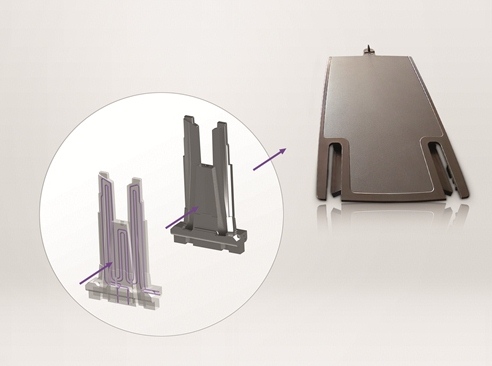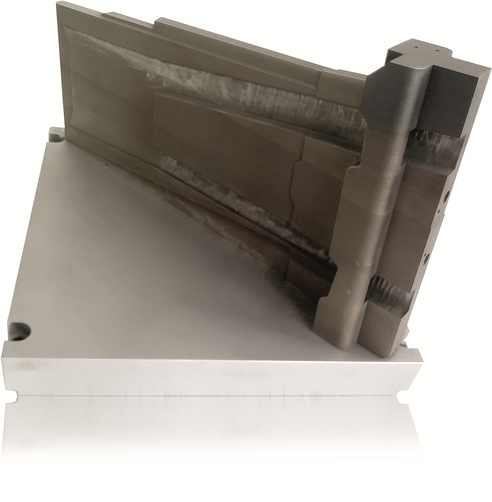Tooling focus: Innomia uses EOS technology to optimise the manufacturing process for moulded automotive components
June 20, 2014
EOS reports that Innomia has become a big advocate of the benefits of Direct Metal Laser Sintering (DMLS) and that it has supported Innomia and the automotive supplier Magna in optimising the production process for injection moulded plastic parts. This involved a revision of the cooling process in the manufacture of an armrest situated between the front seats.
With the quality of plastic vehicle components increasing greatly in recent years, manufacturers and suppliers are relying more and more on such high-tech solutions.
The challenge
The manufacture of the plastic components for the central armrest is undertaken by the supplier Magna, a customer of Innomia. Production is based on the classic injection moulding process. This involves melting plastic filled with glass fibres, injection into the mould cavity and then solidifying. The component can then be subsequently removed and is ready for delivery to the automotive manufacturer or to further suppliers in the chain. Each step must function perfectly in this complex process.
The heat energy of the liquid base material needs to be dissipated throughout the manufacturing tool to enable the plastic to solidify. The cooling process dictates, amongst other things, the quality of the component. This is because irregular heat dissipation can lead to deformations. Beyond that, temperature control plays a major role in dictating the production cycle time. The quicker the heat is removed, the sooner a component can be extracted and the next one produced.
The tool insert used to-date has been made of extremely heat-conducting beryllium-copper alloy and cooling was only possible from one side of the insert. This meant that the temperature distribution was uneven. The cooling water needed to be very cold, just 16°C, in order to absorb the level of heat energy. Through the high insert surface temperatures, up to 120°C, the humidity rose in the vicinity, which, in turn, accelerated corrosion. This resulted in a cost intensive cleaning being necessary every one to two weeks. The hardness of the mould core was all that prevented damage of surfaces during the regular cleaning process.
The solution
As a logical consequence, the designers from Innomia began to develop a new tool insert cooling system. The optimised removal of heat generated in the production process was right at the top of the list of priorities. The team decided to go with integrated precision cooling channels, a tried and tested application under DMLS technology, and one of the solutions that only Additive Manufacturing processes can provide. The EOSINT M 270 system from EOS, a system proven over many years, was deployed for Innomia.

Fig. 1 Tool insert and injection moulding component. Thanks to conformal cooling the cycle time was reduced by 17% and the quality of the armrest part has been improved (Source: Innomia, Magna)
The diameter of the cooling channels is just 3 mm. The metal chosen was Maraging Steel 1.2709. The manufacturing process, namely the layered application and melting of the metal powder corresponding to 3D-data, enabled the employees of the Czech specialists to increase the degree of hardness through post-treatment to over 50 HRC. These mechanical characteristics guarantee a high resistance to wear and thereby reduce the maintenance costs.
“The DMLS process, using the EOSINT M 270, enabled us to manufacture an extremely durable component, while at the same time successfully retaining the proven advantages of the method in terms of design and reduced cycle times,” explained Luboš Rozkošný, CEO at Innomia. “Thanks to the cooling channels, integrated in the component with optimum precision, we have resolved the main challenge of the production process, and done so with limited expense.”
Results
The precision cooling and the production using Additive Manufacturing technology has had the desired results. The temperature distribution and associated heat dissipation are now substantially more homogenized. Since the heat is distributed and leaves both the tool and the component quicker, a water temperature of 60°C is sufficient for cooling – reducing the energy needed. The insert surface itself does not heat up beyond 90°C, a fact that further allowed the engineers to resolve the humidity problems in the surrounding area.
Thanks to Innomia and EOS technology, Magna profits from a maintenance interval that is extended to between five and six weeks. The problem of air humidity condensation and potential cavity corrosion was solved completely. The uniform cooling channels work so well that the time required for the production cycle is now 17% lower than before. As a result of the even and fast distribution and dissipation of heat, the components no longer deform. This has a direct and positive influence on the quality and speed of manufacturing. The reduction of the production cycle time and the improved quality of the end product are simultaneous benefits. After 370,000 cycles, Innomia and Magna have further improved the results. In this period the total savings have already reached some 20,000 euros.

Fig. 2 Additive Manufactured tooling insert on building platform: using EOS technology contributed to an extended maintenance interval and solved the problem of air humidity condensation and potential cavity corrosion completely (Source: Innomia)
Pavel Strnadek, Head of Tool Maintenance at Magna, is very happy with the results, “The issue of cooling was something that we’ve been trying to deal with for a long time. We knew how an improved product would have to look, but manufacturing it just wasn’t possible. Additive Manufacturing allowed us to make the breakthrough. We were able to plan the cooling channels just as we wanted them and then manufacture the mould core correspondingly. The laser fuses the metallic powder layer by layer, so that in effect any shape is possible. The result has convinced us at every level. Maintenance, quality of the end product, costs, heat dissipation – it’s been the perfect project.” Additive Manufacturing technologies are helping companies to deliver the promise of quality in automobile construction – Magna, a supplier to Škoda, demonstrates this on a daily basis.
Rozkošný concluded, “The automobile industry in Europe is subject to stiff competition. This fact naturally has an effect on suppliers such as Magna. That’s why it’s very important for us to be able to produce to the highest quality standards at the lowest price. With the optimisation of our production plant via the improved cooling of our tools, we have created a textbook example of how technology can help increase efficiency. We reduced the maintenance costs for our production plant, optimised the quality of our components and increased the number of production cycles. This enabled us to uphold the promise of quality we made to our client and, at the same time, meet our own high demands regarding cost-effectiveness.”
Useful links
To submit news and articles for publication on Metal Additive Manufacturing email us at [email protected]
Metal-AM homepage | Latest News | Articles | Subscribe to our free e-newsletter
















